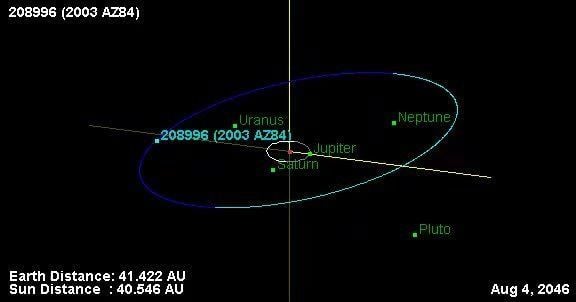Discovery date 13 January 2003 Alternative names 2003 AZ84 | MPC designation (208996) 2003 AZ84 | |
 | ||
Discovered by C. TrujilloM. E. Brown Discovery site NEAT–Palomar Obs. (644) Minor planet category Distant · TNO · Plutino | ||
(208996) 2003 AZ84 is a binary trans-Neptunian object from the outer regions of the Solar System, approximately 700 kilometers in diameter. It belongs to the plutinos – a group of minor planets named after its largest member Pluto – as it orbits in a 2:3 resonance with Neptune in the Kuiper belt. It was discovered on 13 January 2003, by American astronomers Chad Trujillo and Michael Brown during the NEAT survey using the Samuel Oschin telescope at Palomar Observatory.
Contents
Its lightcurve amplitude deviates little from that of an ellipsoid, which suggests that it is likely one with small albedo spots.
Considered a very likely dwarf planet by astronomers Gonzalo Tancredi and Michael Brown, it is currently not recognized as such by the IAU.
Orbit and rotation
2003 AZ84 is a plutino, which means that it is in a 2:3 orbital resonance with Neptune, similar to that of Pluto. It orbits the Sun in just over 247 Earth years. It is currently 45.3 AU from the Sun and came to aphelion (farthest distance from the Sun) in 1982. It will come to perihelion in 2107. Simulations by the Deep Ecliptic Survey (DES) show that over the next 10 million years (208996) 2003 AZ84 will not come closer (qmin) than 31.6 AU from the Sun (it will stay farther away than Neptune).
Two rotational lightcurves of this minor planet were obtained by Scott Sheppard and José Ortiz in 2003 and 2006. Lightcurve analysis gave an ambiguous rotation period of 6.71 and 6.76 hours with a brightness variation of 0.14 and 0.10 in magnitude, respectively (U=2/2-).
Physical characteristics
The Spitzer Space Telescope has estimated its size at 7005686000000000000♠686±96 km, while an analysis of a combination of Spitzer and Hershel data yielded a slightly higher estimate of 7005727000000000000♠727.0+61.9
−66.5 km. These results are in agreement with each other. Its large size (208996) 2003 AZ84 makes it a probable dwarf planet. Its mass is unknown since the satellite has not been recovered.
A stellar occultation in 2010 measured a single chord of 7005573000000000000♠573±21 km. But this is only a lower limit for the diameter of 2003 AZ84 because the chord may not have passed through the center of the body.
The spectra and colors of 2003 AZ84 are very similar to those of Orcus, another large object in 2:3 resonance with Neptune. Both bodies have a flat featureless spectrum in the visible and moderately strong water ice absorption bands in the near-infrared, although 2003 AZ84 has a lower albedo. Both bodies also have a weak absorption band near 2.3 μm, which may be caused by ammonia hydrate or methane ice.
Satellite
Using observations with the Hubble Space Telescope, the discovery of a satellite of 2003 AZ84 was reported in IAUC 8812 on 22 February 2007. The object was measured with a separation of 0.22 arcsec and an apparent magnitude difference of 5.0. As of 2012, attempts to recover the satellite have failed. The unrecovered satellite is estimated to be about 7004680000000000000♠68±20 km in diameter.
